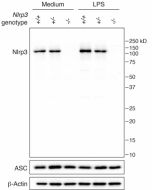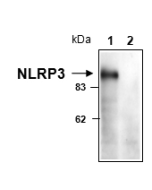Cookie Policy: This site uses cookies to improve your experience. You can find out more about our use of cookies in our Privacy Policy. By continuing to browse this site you agree to our use of cookies.
AdipoGen Life Sciences
anti-NLRC3 (mouse), mAb (Eowyn-1)

Method: Cell lysate protein was loaded and SDS Page was run for 1h at 100V. Transfer for 1h at 80V. Block for 30min with 4% skimmed milk PBS Tween. Nitrocellulose membrane was incubated o/n at 4°C with anti-NLRC3 (mouse), mAb (Eowyn-1) (1/2000) in incubation buffer (0.4% skimmed milk PBS Tween) followed by anti-mouse HRP (1/10‘000) for 1h at RT. Exposure 5 min. Anti-Flag (1/2000) was incubated o/n at 4°C followed by anti-mouse HRP (1/10‘000) for 1h at RT. Exposure 5 min.
Conclusion: anti-NLRC3 (mouse), mAb (Eowyn-1) recognizes overexpressed mouse NLRC3 but it does not detect human NLRC3. -> mouse NLRC3: ≈ 120kDa; human NLRC3: ≈ 115kDa; Flag-tagged mouse NLRC3 and Flag-tagged human NLRC3 were overexpressed in Jurkat cells.
| Product Details | |
|---|---|
| Synonyms | NOD3; Nucleotide-binding Oligomerization Protein 3; CARD15-like Protein; Caterpiller Protein 16.2; CLR16.2 |
| Product Type | Monoclonal Antibody |
| Properties | |
| Clone | Eowyn-1 |
| Isotype | Mouse IgG1 |
| Source/Host | Purified from concentrated hybridoma tissue culture supernatant. |
| Immunogen/Antigen | Recombinant mouse NLRC3 (card domain). |
| Application |
Western Blot: (1μg/ml) |
| Crossreactivity | Mouse |
| Specificity |
Detects overexpressed mouse NLRC3. Doest not detect human NLRC3. Although NLRC3 (mouse), mAb (Eowyn-1) is strong and specific (see figure), the endogenous protein has not been detected yet with this antibody (using NLRC3 KO versus WT immune cells). NLRC3 protein is probably expressed at very low levels or its translation / stability is triggered by stimuli still to be discovered . |
| Purity | ≥95% (SDS-PAGE) |
| Purity Detail | Protein G-affinity purified. |
| Concentration | 1mg/ml |
| Formulation | Liquid. In PBS containing 10% glycerol and 0.02% sodium azide. |
| Isotype Negative Control | |
| Shipping and Handling | |
| Shipping | BLUE ICE |
| Short Term Storage | +4°C |
| Long Term Storage | -20°C |
| Handling Advice |
After opening, prepare aliquots and store at -20°C. Avoid freeze/thaw cycles. |
| Use/Stability | Stable for at least 1 year after receipt when stored at -20°C. |
| Documents | |
| MSDS |
 Download PDF Download PDF |
| Product Specification Sheet | |
| Datasheet |
 Download PDF Download PDF |
The novel nucleotide oligomerization domain (NOD)-like receptor (NLR) with a caspase activation and recruitment domain (CARD) 3 (NLRC3) protein belongs to the NLR family of cytosolic pathogen recognition receptors. NLRC3 has the characteristic NOD and leucine-rich repeat configuration with a less well defined CARD. NLRC3 is expressed in T lymphocytes and may be involved in suppression of T cell activation. NLRC3 is a cytoplasmic protein that negatively regulates pro-IL-1β maturation and inhibits toll-like receptor (TLR)-dependent activation of the transcription factor NF-κB. NLRC3 interacts with the TLR signaling adaptor TRAF6 to attenuate Lys63 (K63)-linked ubiquitination of TRAF6 and activation of NF-κB. NLRC3 also reduces STING-dependent innate immune activation in response to cytosolic DNA, cyclic di-GMP (c-di-GMP) and DNA viruses. NLRC3 associated with both STING and TBK1, impedes STING-TBK1 interaction and downstream type I interferon production.







